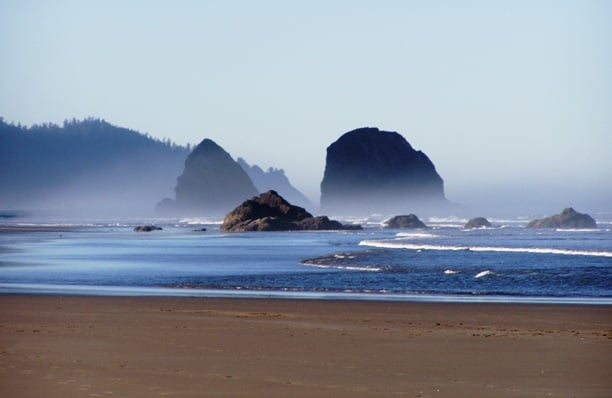Sculpted by the turbulent, pounding waves of the Pacific, Oregon’s 362-mile coastline is one of nature’s masterworks. Thanks to a far-sighted state government in the 1910s, the entire length of the coast in Oregon was set aside as public land, which has left most of it, especially in the central and southern regions, largely undeveloped.

For one of the most awe-inspiring road trips in America, follow U.S. Route 101 and the western edge of the continent from north to south. Begin at the northern outpost of Astoria, the richly historic city where the Columbia River flows into the Pacific. At Cannon Beach, northern Oregon’s most beautiful seaside village, sandy beaches stretch for miles, interrupted by massive basalt sea stacks such as the iconic 235-foot Haystack Rock. Route 101 stays close to the coast, traversing river valleys and climbing up over the flanks of mountains that reach down to the Pacific. The view from Neahkahnie Mountain, where the road edges around 700-foot cliffs that drop into the surging Pacific, is of wide-open seascape—on a clear day, you can see for 50 miles.
At Tillamook, home to dozens of dairies and the famed Tillamook Cheese Factory, the highway tucks inland, passing forests and dairy and artichoke farms, before rejoining the Pacific at Lincoln City, just north of Oregon’s beloved Salishan Spa and Golf Resort.
Newport is the central Oregon coast’s largest city, a hard-working seaport dominated by a high-arching bridge. The Oregon Coast Aquarium, once home to the orca Keiko (of Free Willy film fame) and one of the coast’s top attractions, provides a fascinating glimpse into the northern Pacific’s sea and intertidal life (a favourite resident is the octopus, with a 20-foot span). Or encounter Oregon’s aquatic life in the wild—at Newport’s harbour, join a whale-watching tour and journey out into the Pacific, where grey whales breach and spout as they pass between their winter and summer feeding grounds. About 20,000 pass by here each year, and when the numbers are dense, you don’t even have to leave shore to watch. Newport’s quirky Sylvia Beach Hotel (named after the American owner of the Shakespeare and Co. bookstore in Paris during the 1920s and ’30s) is the coast’s most unusual refuge—a hotel dedicated to book-lovers. Its 20 guest rooms are decorated to evoke the spirit and work of various authors, including Agatha Christie, Colette and Mark Twain. Even non-guests should book at the hotel’s well-regarded Tables of Content restaurant and hope for the ubiquitous fresh oysters for which Newport is widely known.
South of Yachats (pronounced YA-hots) is the most rugged stretch of the Oregon coastline, where ancient volcanoes and lava flows meet the Pacific. Towering 830 feet above the roiling waters, Cape Perpetua is one of the area’s highest points, in every sense of the word, with scenic lookouts and hiking trails. Just south is Heceta Head Lighthouse, probably the most photographed vista in all of Oregon. This stark white, functioning lighthouse on a rocky headland 205 feet above the Pacific is jaw-droppingly dramatic. The beautifully maintained 1894 lighthouse keeper’s home is one of the very few in the U.S. that is open as a B&B. The breakfasts enjoy a certain fame, as does the resident ghost. The nearby Sea Lion Caves is another natural wonder—a natural sea grotto, the largest in the country, populated by smelly, shrieking sea lions. A 208-foot lift descends into the sea cave, where you can watch hundreds of Steller sea lions clambering on to the rocks, jockeying for position, and letting loose mighty roars (bulls can weigh more than a ton).
South of Florence, the Oregon Dunes, among the largest oceanfront sand dunes in the world, extend along the coast for over 50 miles. Hiking trails explore this unusual ecosystem, linking scrub forests, small lakes and some 14,000 acres of mighty, ever-shifting dunes, some measuring up to 500 feet high.
From Charleston south to the California border, the beaches are increasingly flanked by high cliffs and craggy teeth of rock, home to rookeries of puffins, penguin-like murres and wheeling gulls. Human comforts are not abandoned, however. Bandon, one of the most charming towns along the coast, is equal parts New Age retreat and golf mecca. The state’s most famous river, the fast-flowing Rogue, meets the Pacific at Gold River; just upstream is an excellent lodge and opportunities for unmatched fishing and exhilarating jet-boat trips on the river’s surging rapids.
Drive off into the sunset, as Route 101’s final stretch in Oregon keeps getting more and more beautiful. Just six miles above the California border, Brookings basks in Oregon’s ‘banana belt’: mild winter temperatures enable palm trees to grow in this pleasant harbour city, and wild azaleas bloom every year in late May. But this is also home to the northernmost range of the West’s giant coast redwoods, more commonly associated with northern California.
